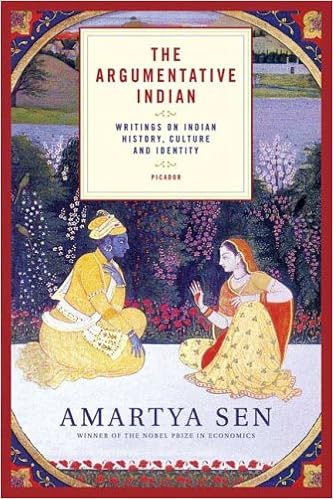
The Argumentative Indian: Writing on Indian History,Culture and Identity, by Amartya Sen,
Farrar, Strass and Giroux, New York, 2005, 409 pp, Hardcover, $6.61 on Amazon, ISBN: 978-0-374-10583-9
by Arnold Zeitlin 6 July 2020
Polymath economist and Nobel Prize laureate Amartya Sen’s sentiments, written more than two decades ago about the land of his birth and published in The Argumentative Indian in 2005 as a collection of 16 essays, resonate in contemporary India.
Noting the tens of millions of Muslims who live in India, Sen writes:
“To see India just as a Hindu country is a fairly bizarre idea in the face of that fact alone, not to mention the intermingling of Hindus and Muslims in the social and cultural life of India (in literature, music, painting and so on)…There is a large and prominent Sikh population, and a substantial number of Christians, whose settlements go back at least to the fourth century CE. There have also been Jewish settlements in India for nearly two thousand years. Parsees started moving to India twelve hundred years ago, to escape a less tolerant Iran. To this, we have to add the millions of Jains and practitioners of Buddhism, which had been for a long period the official religion of the Indian emperors….Furthermore, large also is the number of Indians who are atheist or agnostic (as Jawaharlal Nehru himself was)….”
There is nothing “fairly” about the bizarre state, but Sen, like many intellectuals, often is reluctant to say directly what they feel.
These remarks are in his book in an essay entitled Secularism and Its Discontents, which Sen initially published separately in 1996, just as the Bharatiya Janata Party (BJP) was first assuming power with its program of Hindu nationalism. Now, under Prime Minister Narendra Modi, the BJP, its Lok Sabha majority overwhelming, is pushing anti-Muslim postures on citizenship and immigration as part of its program to promote a concept called Hindutva, which determines that far from being a secular state, India with its almost 900 million Hindus is a Hindu nation.
Throughout his essays in this book, Sen seeks to rebut Hindutva. He is a Hindu from his birth 87 years ago in the part of Bengal that has become Bangladesh as well as claiming to be an atheist in the tradition of the Carvaka – Lokayota philosophy that may be dated beyond 600 BCE and may be summed up briefly in this ancient poem:
There is no other world other than this;
There is no heaven and no hell;
The realm of Shiva and like regions,
are fabricated by stupid imposters.
Since the publication of this book in 2005, Sen, with occasional visits to India, has sheltered in Cambridge, Massachusetts, where he serves as Thomas W. Lamont university professor at Harvard University. His view of Indian politics may have unhappily hardened, as the following excerpt from a 2019 interview indicates:
“Today, everything is dominated by hard-nosed, hard-Hindutva thinking. And the President, Prime Minister, the leadership all are Hindu. But if you compare that to a dozen years ago, 2007, let’s say, we had a Muslim President, a Sikh Prime Minister, a Christian leader of the ruling party. The majority of the parliamentarians were Hindu, but they were not trying to impose their way of thinking over everyone. And that’s what happened….So there is a decline not only from secularism and democracy in post-independence India but also in the understanding of the heritage even of Hindu India.”
Throughout these essays, Sen repeatedly returns to ancients, who are his idols. One is Ashoka, the third century BCE Maurya dynasty emperor, who ruled an immense sub-continental empire and who, in Sen’s words “outlined the need for toleration and the richness of heterodoxy.” Another is Akbar, the 16th-century Muslim emperor who delivered “the most powerful defense of toleration and the need for the state of being equidistant from different religions….”,
The 16 essays deal with the Indian identity, with class and the status of women, with the Indian diaspora and with India and the West. They make for rich reading. Sen starts with an essay that identifies the Indian as particularly argumentative, hence the title of the collection.
“heterodoxy has been championed in many different ways throughout Indian history,” writes Sen. “and the argumentative tradition remains very much alive today.”
Yet his evidence of an argumentative nature in India is slim. Anecdotally, Indians do not seem as argumentative as Jews or Italians. Indians have been remarkably tolerant, for example, in their helter-skelter relationship with their Chinese neighbor. Sen devotes an entire essay to that relationship, focusing more on China-India exchanges in the first millennium than on the present.
He emerges from his discussion of the first 1,500 years of a China-India relationship to note that the Kerela state, with its “India-stye multi-party democracy,” has managed a decline in its fertility rate “substantially faster than in China, despite the coercive birth-control policies of the latter,” a reference to the one-child policy that China only recently has altered. Sen adds:
“There are great lessons also from China’s early move to universalized health care and basic education. But the role of democratic participation in India suggests that some learning and understanding may go in the other direction as well”.
Yet in another essay, he unhappily compares China’s performance in achieving rapid economic growth, reducing poverty, extending life expectancy, and creating almost universal literacy to India’s less successful attainments, which he describes as “central failures of Indian society.”
With words that apply to contemporary India, Sen concludes:
“It is not enough to continue to have systematic elections, safeguard political liberties and civil rights, and guarantee free speech and an open media. Nor is it adequate to eliminate famine, or to reduce the lead of China on longevity and survival. A more vigorous — and vocal — use of democratic participation can do much more in India than it has already achieved.”
